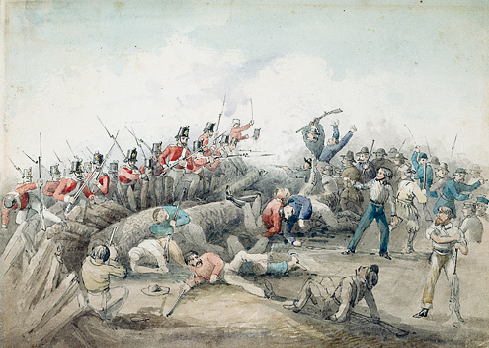The Eureka Stockade
On the 3rd of December 1854 a terrible dawn battle was fought on the ballarat gold fields between the angry diggers and police troopers that only lasted about 20 minutes. The Eureka Stockade was known for the battlers .

What was the Eureka Stockade?
The Eureka Stockade was most commonly known for the miners and diggers protesting against there high price licence fees and the troopers who carried out checks and enforced the licence fees. The licence was put in place in an attempt to stop the mad rush of men to the gold fields. Government authorities hoped that an expensive licence (then 30shillings) would stop at least some of them from deserting there jobs and farms. It would also put money in the governments 'purse' to pay for the construction of roads and the provision of law and order.
Where did the Eureka stockade happen?
The site of where the Eureka stockade happened was a place now commonly known as eureka stockade gardens in Ballarat Victoria. The gardens were officially recognized as a heritage listed monument in 2004. The Eureka Stockade Gardens has become a symbol of democratic protest and national identity.

Why did the Eureka stockade happen?
The Eureka Stockade happened because of a combination of things including overwhelming fees for a "miner's permit" and the backbreaking conditions on the gold fields. A further issue fuelling the rebellion was the questionable death of one young miner and the beating of another at the hands of Police. (It should be noted that at this point in history, the Victoria Police were very corrupt, and many of the lower ranks in the force were little more than criminals themselves.)
What does the Eureka Flag represent?
The Eureka Flag represents how the "downtrodden" in Australia could fight for their rights. It is the oldest flag in Australia, and symbolic in that it was designed by the people it represented, not some far-off government authority.
The five stars on the Eureka flag represent the Southern Cross, which has always been symbolic for Australians, and the white cross joining the stars represents unity in defiance against unnecessary authority.

Who were the people involved in the Eureka Stockade?
The main people involved in the Eureka Stockade were the gold miners in Ballarat, Victoria, Australia in 1854, and 276 police and military personnel. About 500 diggers barricaded themselves inside the stockade.
Irish immigrant Peter Lalor was elected to lead the Eureka Stockade rebellion. Following the rebellion, miners were awarded democratic representation: Peter Lalor and another representative, John Basson Humffray, were elected for Ballarat.
 | Name: Peter Lalor Peter Lalor is a name well-known in Australian history as one of the leaders of the miners at the 1854 Eureka Stockade uprising. During the attack on the Eureka Stockade in the early hours of Saturday, 3 December 1854, when the police stormed the stockade killing thirty or more diggers and taking over one hundred prisoners, Lalor's left arm was injured. He escaped and reached the home of Father Smyth in Ballarat where the arm was amputated, and was then taken to Geelong where he was cared for by Alicia Dunne, whom he married on 10 July 1855. |
How long did the Eureka Stockade go for?
In the Eureka Stockade, the actual clash between the troopers and the miners occurred on just one day. The lead up, however, lasted longer.
On 29 November 1854, the miners burned their licences in a mass display of resistance against the laws which controlled the miners.
On November 30, Irish immigrant Peter Lalor was elected to lead the rebellion after a huge licence hunt.
On December 1, the miners began to construct a wooden barricade, the Eureka Stockade, from which they planned to defend themselves against further licence arrests or other incursions by the authorities.
It was completed by Saturday, 2 December.
At about 4:00am on Sunday, 3 December 1854, 276 police and military personnel and several civilians stormed the stockade. The clash lasted until about 7am. "Officially", the battle was recorded as lasting 20 minutes.
a proper timeline of The Eureka Stockade: http://www.eurekaballarat.com/images/stories/eureka_timeline.pdf

What was the outcome of the Eureka Stockade?
The outcome of the Eureka Stockade is that the miners fought for their rights and better laws on the miners licence and the court decided to make the licence 1pound a year. In the battle of the Eureka Stockade, 22 diggers and 5 troopers died.
Ultimately, though, the Eureka Stockade gained the attention of the Government. A Commission of Enquiry was conducted and changes were implemented. These included abolition of monthly gold licences, replaced by an affordable annual miner's licence. The numbers of troopers were reduced significantly, and Legislative Council was expanded to allow representation to the major goldfields. Peter Lalor and another representative, John Basson Humffray, were elected for Ballarat. Later, Lalor was elected Speaker of the Legislative Assembly of Victoria. For these reasons, the Eureka Stockade is regarded by many as the birthplace of Australian Democracy.
